Warehouse Performance and Future Trends
VerifiedAdded on 2023/04/03
|19
|3962
|324
AI Summary
This document discusses the concept of warehouse performance and its future trends. It covers topics such as warehouse management, integration, strategic storage, and the use of AI and automated systems. The goal is to improve efficiency, reduce costs, and optimize warehouse operations.
Contribute Materials
Your contribution can guide someone’s learning journey. Share your
documents today.
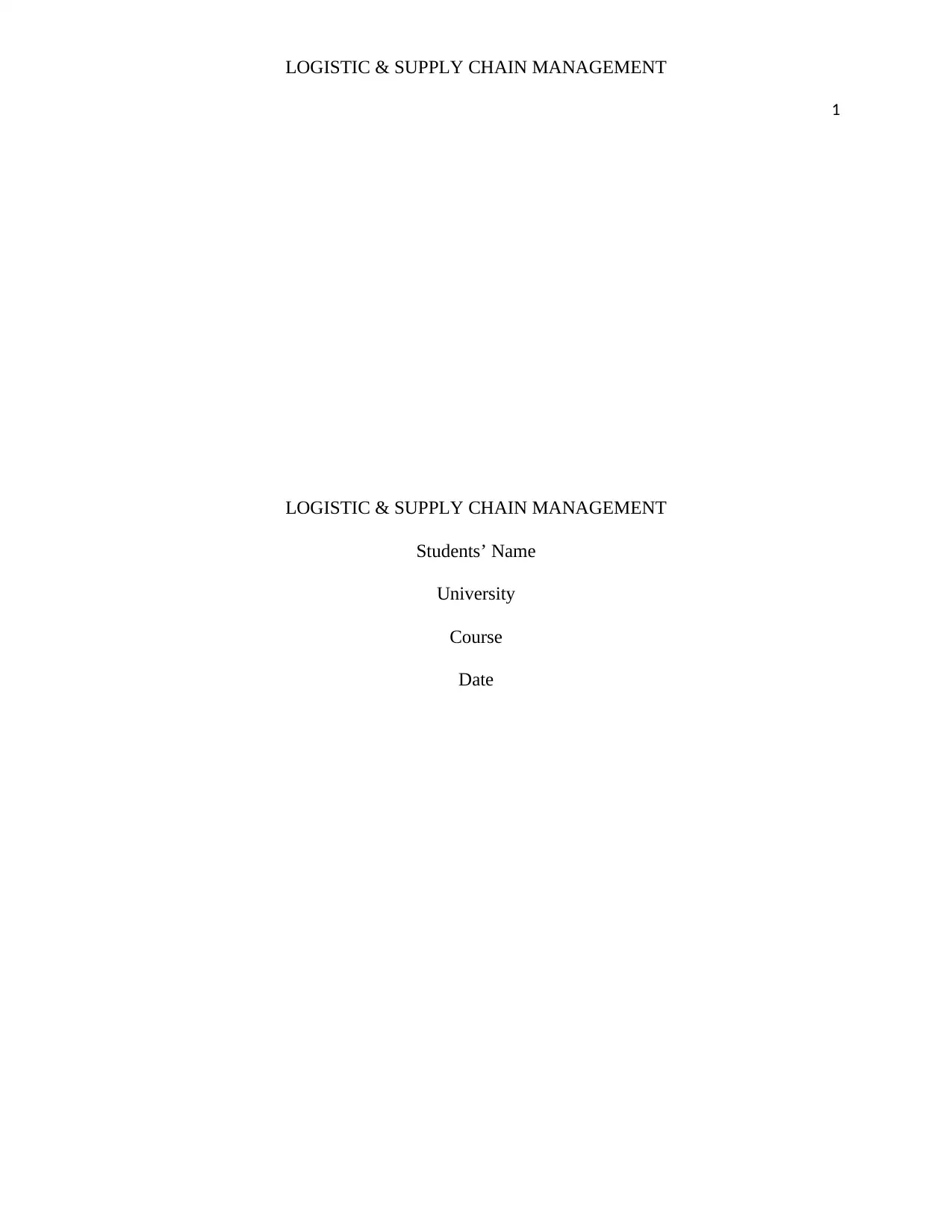
LOGISTIC & SUPPLY CHAIN MANAGEMENT
1
LOGISTIC & SUPPLY CHAIN MANAGEMENT
Students’ Name
University
Course
Date
1
LOGISTIC & SUPPLY CHAIN MANAGEMENT
Students’ Name
University
Course
Date
Secure Best Marks with AI Grader
Need help grading? Try our AI Grader for instant feedback on your assignments.
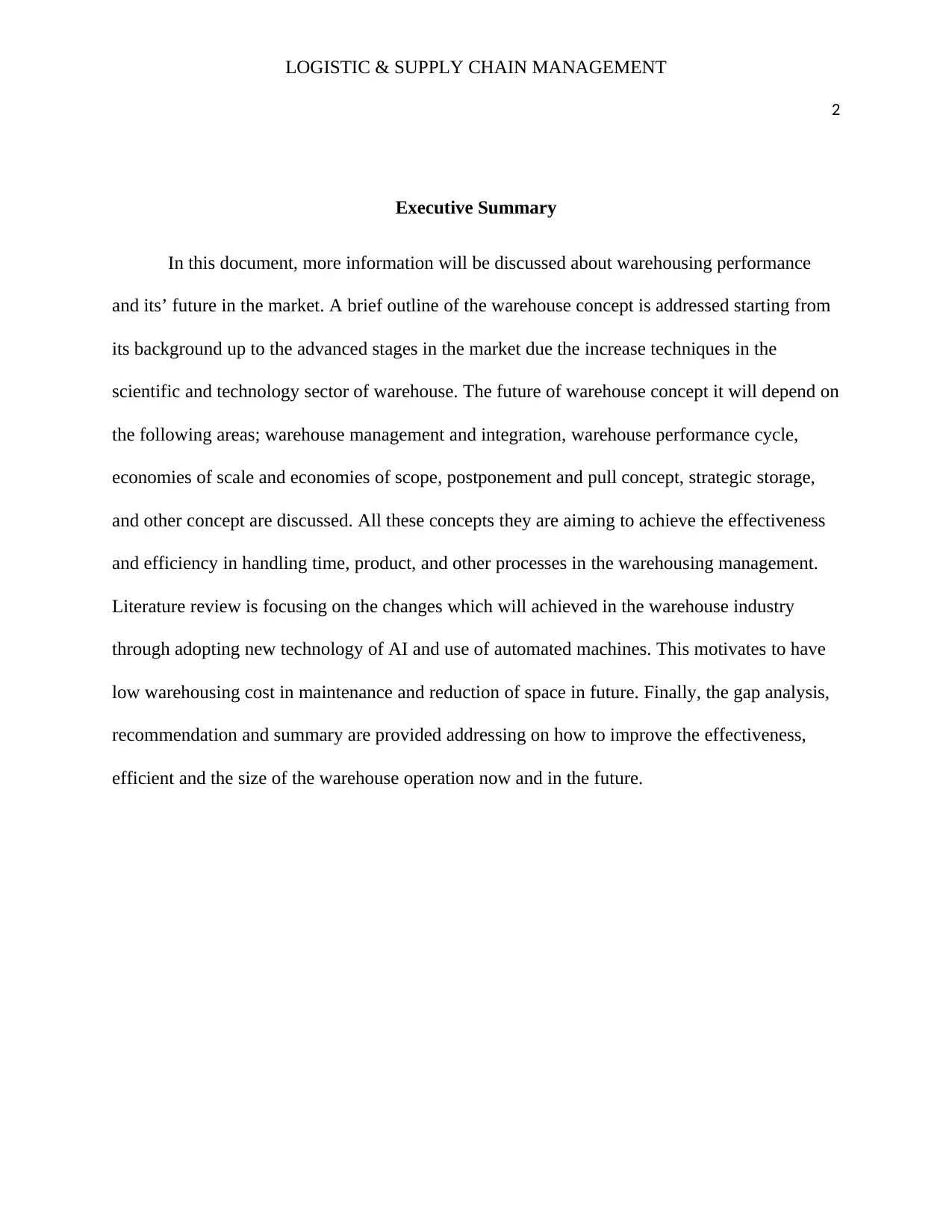
LOGISTIC & SUPPLY CHAIN MANAGEMENT
2
Executive Summary
In this document, more information will be discussed about warehousing performance
and its’ future in the market. A brief outline of the warehouse concept is addressed starting from
its background up to the advanced stages in the market due the increase techniques in the
scientific and technology sector of warehouse. The future of warehouse concept it will depend on
the following areas; warehouse management and integration, warehouse performance cycle,
economies of scale and economies of scope, postponement and pull concept, strategic storage,
and other concept are discussed. All these concepts they are aiming to achieve the effectiveness
and efficiency in handling time, product, and other processes in the warehousing management.
Literature review is focusing on the changes which will achieved in the warehouse industry
through adopting new technology of AI and use of automated machines. This motivates to have
low warehousing cost in maintenance and reduction of space in future. Finally, the gap analysis,
recommendation and summary are provided addressing on how to improve the effectiveness,
efficient and the size of the warehouse operation now and in the future.
2
Executive Summary
In this document, more information will be discussed about warehousing performance
and its’ future in the market. A brief outline of the warehouse concept is addressed starting from
its background up to the advanced stages in the market due the increase techniques in the
scientific and technology sector of warehouse. The future of warehouse concept it will depend on
the following areas; warehouse management and integration, warehouse performance cycle,
economies of scale and economies of scope, postponement and pull concept, strategic storage,
and other concept are discussed. All these concepts they are aiming to achieve the effectiveness
and efficiency in handling time, product, and other processes in the warehousing management.
Literature review is focusing on the changes which will achieved in the warehouse industry
through adopting new technology of AI and use of automated machines. This motivates to have
low warehousing cost in maintenance and reduction of space in future. Finally, the gap analysis,
recommendation and summary are provided addressing on how to improve the effectiveness,
efficient and the size of the warehouse operation now and in the future.
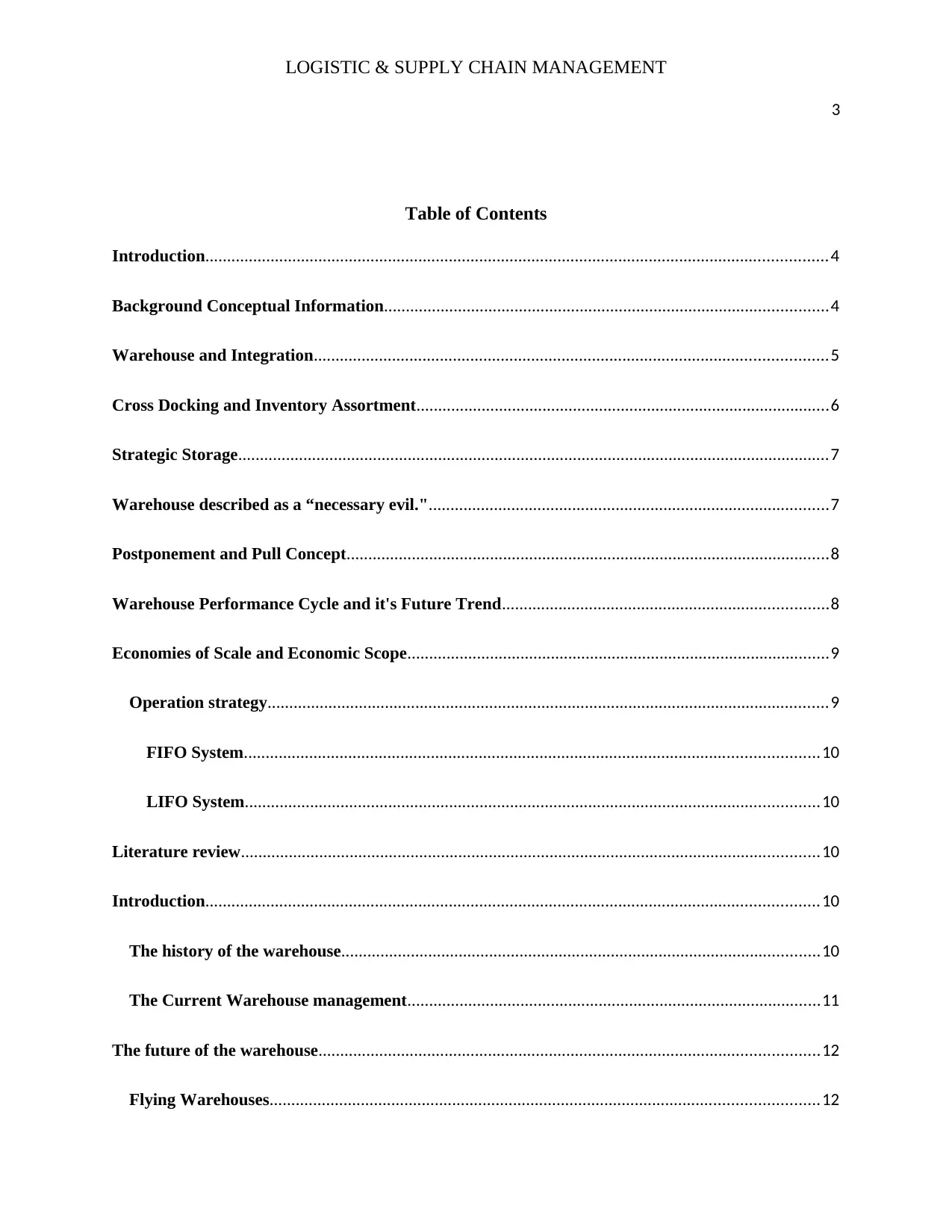
LOGISTIC & SUPPLY CHAIN MANAGEMENT
3
Table of Contents
Introduction...............................................................................................................................................4
Background Conceptual Information......................................................................................................4
Warehouse and Integration......................................................................................................................5
Cross Docking and Inventory Assortment...............................................................................................6
Strategic Storage........................................................................................................................................7
Warehouse described as a “necessary evil."............................................................................................7
Postponement and Pull Concept...............................................................................................................8
Warehouse Performance Cycle and it's Future Trend...........................................................................8
Economies of Scale and Economic Scope.................................................................................................9
Operation strategy.................................................................................................................................9
FIFO System....................................................................................................................................10
LIFO System....................................................................................................................................10
Literature review.....................................................................................................................................10
Introduction.............................................................................................................................................10
The history of the warehouse..............................................................................................................10
The Current Warehouse management...............................................................................................11
The future of the warehouse...................................................................................................................12
Flying Warehouses..............................................................................................................................12
3
Table of Contents
Introduction...............................................................................................................................................4
Background Conceptual Information......................................................................................................4
Warehouse and Integration......................................................................................................................5
Cross Docking and Inventory Assortment...............................................................................................6
Strategic Storage........................................................................................................................................7
Warehouse described as a “necessary evil."............................................................................................7
Postponement and Pull Concept...............................................................................................................8
Warehouse Performance Cycle and it's Future Trend...........................................................................8
Economies of Scale and Economic Scope.................................................................................................9
Operation strategy.................................................................................................................................9
FIFO System....................................................................................................................................10
LIFO System....................................................................................................................................10
Literature review.....................................................................................................................................10
Introduction.............................................................................................................................................10
The history of the warehouse..............................................................................................................10
The Current Warehouse management...............................................................................................11
The future of the warehouse...................................................................................................................12
Flying Warehouses..............................................................................................................................12
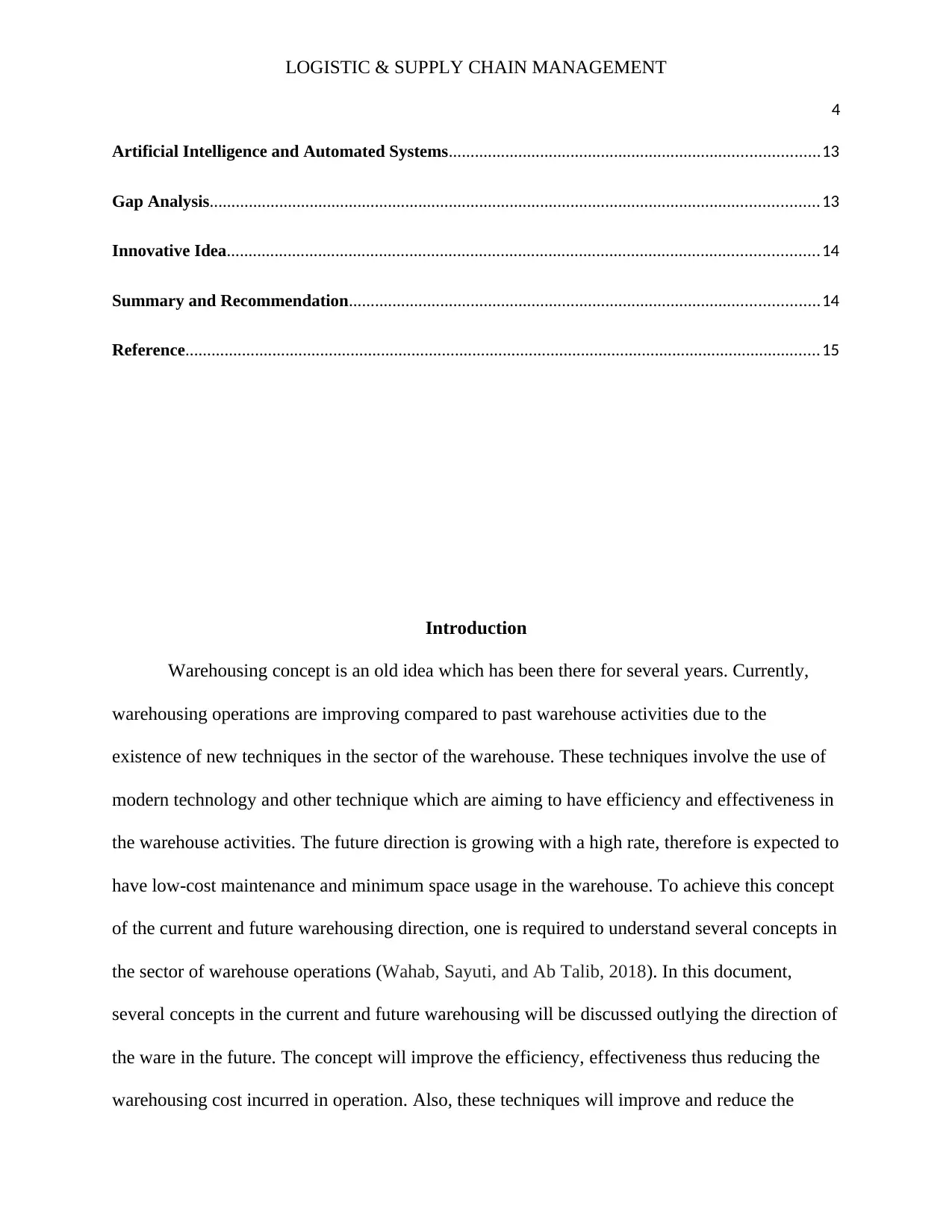
LOGISTIC & SUPPLY CHAIN MANAGEMENT
4
Artificial Intelligence and Automated Systems.....................................................................................13
Gap Analysis............................................................................................................................................13
Innovative Idea........................................................................................................................................14
Summary and Recommendation............................................................................................................14
Reference..................................................................................................................................................15
Introduction
Warehousing concept is an old idea which has been there for several years. Currently,
warehousing operations are improving compared to past warehouse activities due to the
existence of new techniques in the sector of the warehouse. These techniques involve the use of
modern technology and other technique which are aiming to have efficiency and effectiveness in
the warehouse activities. The future direction is growing with a high rate, therefore is expected to
have low-cost maintenance and minimum space usage in the warehouse. To achieve this concept
of the current and future warehousing direction, one is required to understand several concepts in
the sector of warehouse operations (Wahab, Sayuti, and Ab Talib, 2018). In this document,
several concepts in the current and future warehousing will be discussed outlying the direction of
the ware in the future. The concept will improve the efficiency, effectiveness thus reducing the
warehousing cost incurred in operation. Also, these techniques will improve and reduce the
4
Artificial Intelligence and Automated Systems.....................................................................................13
Gap Analysis............................................................................................................................................13
Innovative Idea........................................................................................................................................14
Summary and Recommendation............................................................................................................14
Reference..................................................................................................................................................15
Introduction
Warehousing concept is an old idea which has been there for several years. Currently,
warehousing operations are improving compared to past warehouse activities due to the
existence of new techniques in the sector of the warehouse. These techniques involve the use of
modern technology and other technique which are aiming to have efficiency and effectiveness in
the warehouse activities. The future direction is growing with a high rate, therefore is expected to
have low-cost maintenance and minimum space usage in the warehouse. To achieve this concept
of the current and future warehousing direction, one is required to understand several concepts in
the sector of warehouse operations (Wahab, Sayuti, and Ab Talib, 2018). In this document,
several concepts in the current and future warehousing will be discussed outlying the direction of
the ware in the future. The concept will improve the efficiency, effectiveness thus reducing the
warehousing cost incurred in operation. Also, these techniques will improve and reduce the
Secure Best Marks with AI Grader
Need help grading? Try our AI Grader for instant feedback on your assignments.
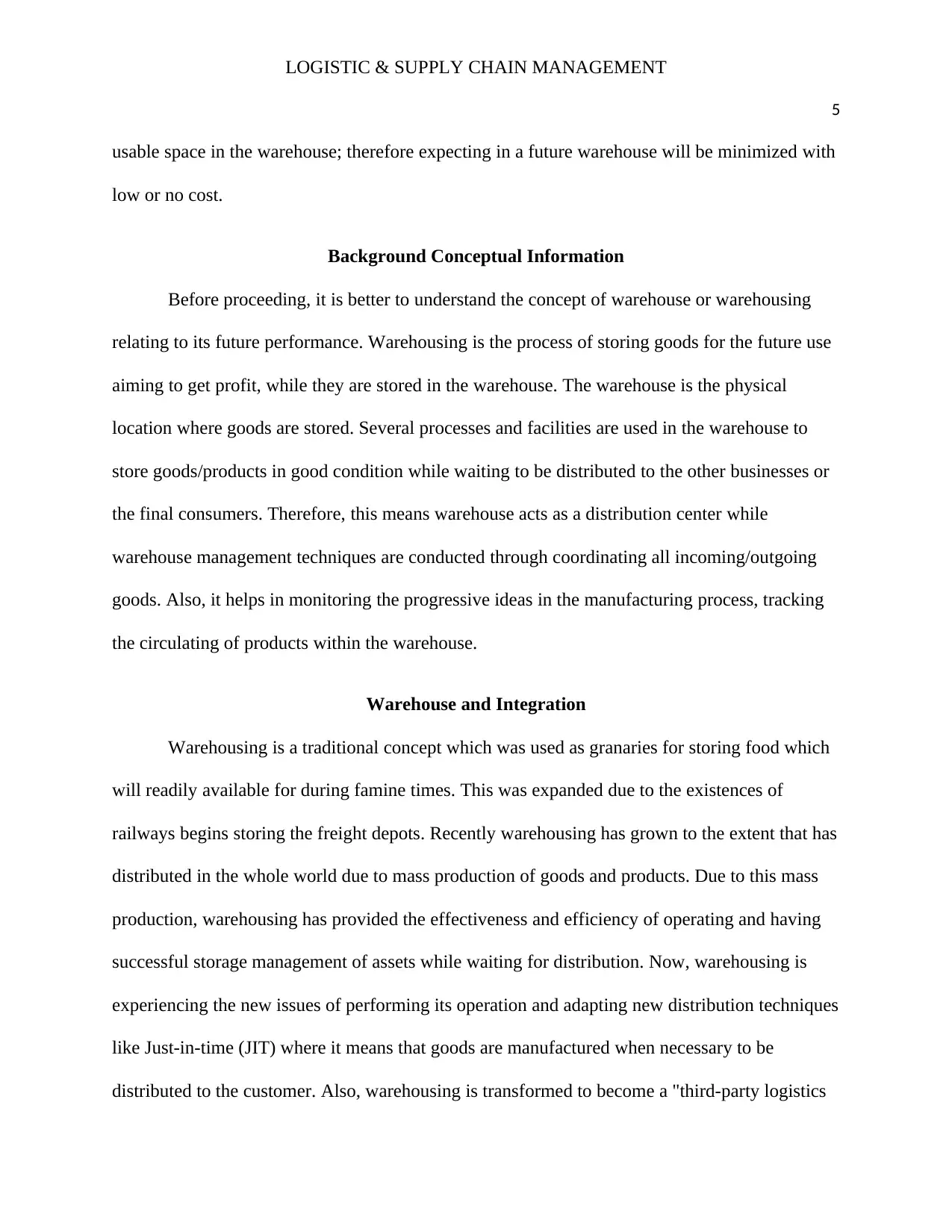
LOGISTIC & SUPPLY CHAIN MANAGEMENT
5
usable space in the warehouse; therefore expecting in a future warehouse will be minimized with
low or no cost.
Background Conceptual Information
Before proceeding, it is better to understand the concept of warehouse or warehousing
relating to its future performance. Warehousing is the process of storing goods for the future use
aiming to get profit, while they are stored in the warehouse. The warehouse is the physical
location where goods are stored. Several processes and facilities are used in the warehouse to
store goods/products in good condition while waiting to be distributed to the other businesses or
the final consumers. Therefore, this means warehouse acts as a distribution center while
warehouse management techniques are conducted through coordinating all incoming/outgoing
goods. Also, it helps in monitoring the progressive ideas in the manufacturing process, tracking
the circulating of products within the warehouse.
Warehouse and Integration
Warehousing is a traditional concept which was used as granaries for storing food which
will readily available for during famine times. This was expanded due to the existences of
railways begins storing the freight depots. Recently warehousing has grown to the extent that has
distributed in the whole world due to mass production of goods and products. Due to this mass
production, warehousing has provided the effectiveness and efficiency of operating and having
successful storage management of assets while waiting for distribution. Now, warehousing is
experiencing the new issues of performing its operation and adapting new distribution techniques
like Just-in-time (JIT) where it means that goods are manufactured when necessary to be
distributed to the customer. Also, warehousing is transformed to become a "third-party logistics
5
usable space in the warehouse; therefore expecting in a future warehouse will be minimized with
low or no cost.
Background Conceptual Information
Before proceeding, it is better to understand the concept of warehouse or warehousing
relating to its future performance. Warehousing is the process of storing goods for the future use
aiming to get profit, while they are stored in the warehouse. The warehouse is the physical
location where goods are stored. Several processes and facilities are used in the warehouse to
store goods/products in good condition while waiting to be distributed to the other businesses or
the final consumers. Therefore, this means warehouse acts as a distribution center while
warehouse management techniques are conducted through coordinating all incoming/outgoing
goods. Also, it helps in monitoring the progressive ideas in the manufacturing process, tracking
the circulating of products within the warehouse.
Warehouse and Integration
Warehousing is a traditional concept which was used as granaries for storing food which
will readily available for during famine times. This was expanded due to the existences of
railways begins storing the freight depots. Recently warehousing has grown to the extent that has
distributed in the whole world due to mass production of goods and products. Due to this mass
production, warehousing has provided the effectiveness and efficiency of operating and having
successful storage management of assets while waiting for distribution. Now, warehousing is
experiencing the new issues of performing its operation and adapting new distribution techniques
like Just-in-time (JIT) where it means that goods are manufactured when necessary to be
distributed to the customer. Also, warehousing is transformed to become a "third-party logistics
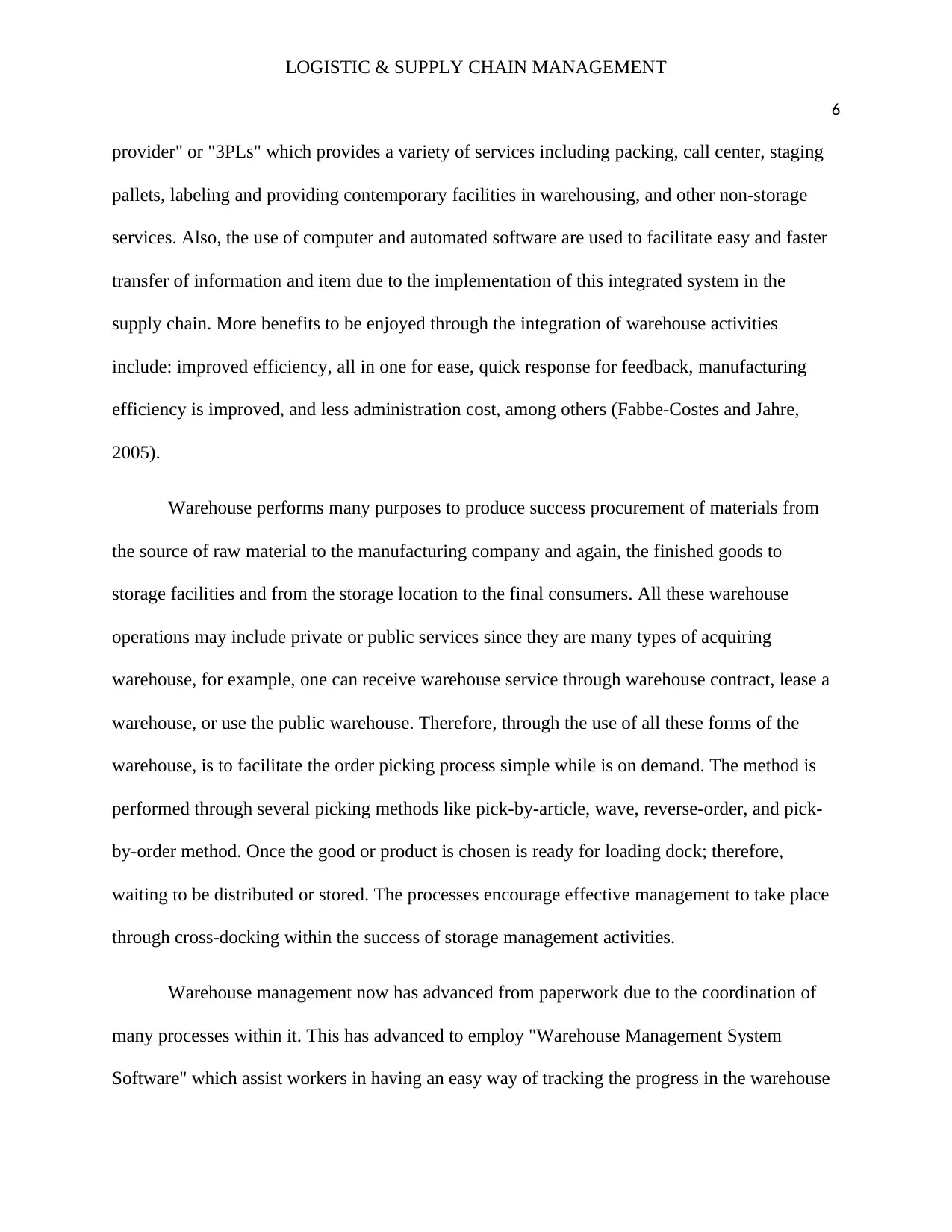
LOGISTIC & SUPPLY CHAIN MANAGEMENT
6
provider" or "3PLs" which provides a variety of services including packing, call center, staging
pallets, labeling and providing contemporary facilities in warehousing, and other non-storage
services. Also, the use of computer and automated software are used to facilitate easy and faster
transfer of information and item due to the implementation of this integrated system in the
supply chain. More benefits to be enjoyed through the integration of warehouse activities
include: improved efficiency, all in one for ease, quick response for feedback, manufacturing
efficiency is improved, and less administration cost, among others (Fabbe-Costes and Jahre,
2005).
Warehouse performs many purposes to produce success procurement of materials from
the source of raw material to the manufacturing company and again, the finished goods to
storage facilities and from the storage location to the final consumers. All these warehouse
operations may include private or public services since they are many types of acquiring
warehouse, for example, one can receive warehouse service through warehouse contract, lease a
warehouse, or use the public warehouse. Therefore, through the use of all these forms of the
warehouse, is to facilitate the order picking process simple while is on demand. The method is
performed through several picking methods like pick-by-article, wave, reverse-order, and pick-
by-order method. Once the good or product is chosen is ready for loading dock; therefore,
waiting to be distributed or stored. The processes encourage effective management to take place
through cross-docking within the success of storage management activities.
Warehouse management now has advanced from paperwork due to the coordination of
many processes within it. This has advanced to employ "Warehouse Management System
Software" which assist workers in having an easy way of tracking the progress in the warehouse
6
provider" or "3PLs" which provides a variety of services including packing, call center, staging
pallets, labeling and providing contemporary facilities in warehousing, and other non-storage
services. Also, the use of computer and automated software are used to facilitate easy and faster
transfer of information and item due to the implementation of this integrated system in the
supply chain. More benefits to be enjoyed through the integration of warehouse activities
include: improved efficiency, all in one for ease, quick response for feedback, manufacturing
efficiency is improved, and less administration cost, among others (Fabbe-Costes and Jahre,
2005).
Warehouse performs many purposes to produce success procurement of materials from
the source of raw material to the manufacturing company and again, the finished goods to
storage facilities and from the storage location to the final consumers. All these warehouse
operations may include private or public services since they are many types of acquiring
warehouse, for example, one can receive warehouse service through warehouse contract, lease a
warehouse, or use the public warehouse. Therefore, through the use of all these forms of the
warehouse, is to facilitate the order picking process simple while is on demand. The method is
performed through several picking methods like pick-by-article, wave, reverse-order, and pick-
by-order method. Once the good or product is chosen is ready for loading dock; therefore,
waiting to be distributed or stored. The processes encourage effective management to take place
through cross-docking within the success of storage management activities.
Warehouse management now has advanced from paperwork due to the coordination of
many processes within it. This has advanced to employ "Warehouse Management System
Software" which assist workers in having an easy way of tracking the progress in the warehouse
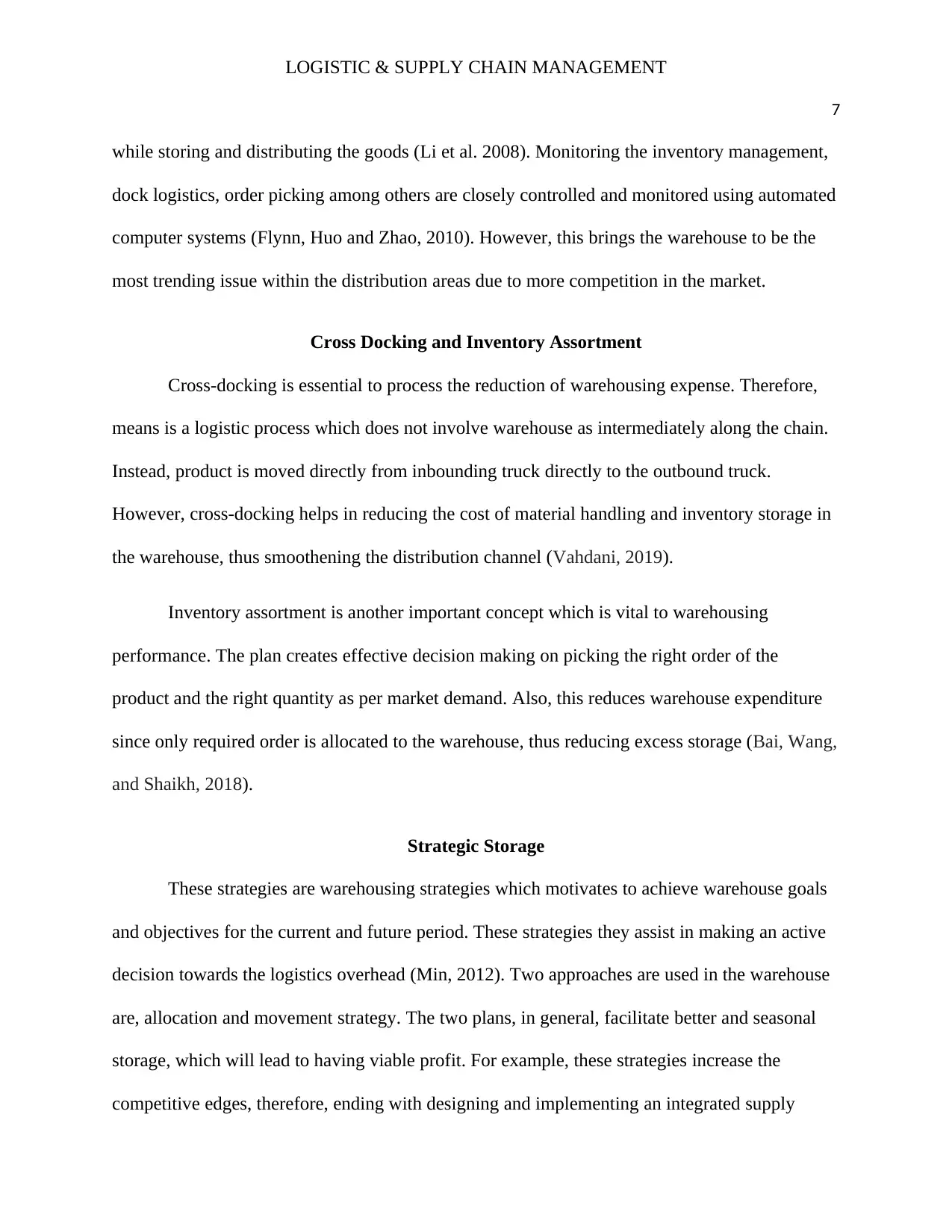
LOGISTIC & SUPPLY CHAIN MANAGEMENT
7
while storing and distributing the goods (Li et al. 2008). Monitoring the inventory management,
dock logistics, order picking among others are closely controlled and monitored using automated
computer systems (Flynn, Huo and Zhao, 2010). However, this brings the warehouse to be the
most trending issue within the distribution areas due to more competition in the market.
Cross Docking and Inventory Assortment
Cross-docking is essential to process the reduction of warehousing expense. Therefore,
means is a logistic process which does not involve warehouse as intermediately along the chain.
Instead, product is moved directly from inbounding truck directly to the outbound truck.
However, cross-docking helps in reducing the cost of material handling and inventory storage in
the warehouse, thus smoothening the distribution channel (Vahdani, 2019).
Inventory assortment is another important concept which is vital to warehousing
performance. The plan creates effective decision making on picking the right order of the
product and the right quantity as per market demand. Also, this reduces warehouse expenditure
since only required order is allocated to the warehouse, thus reducing excess storage (Bai, Wang,
and Shaikh, 2018).
Strategic Storage
These strategies are warehousing strategies which motivates to achieve warehouse goals
and objectives for the current and future period. These strategies they assist in making an active
decision towards the logistics overhead (Min, 2012). Two approaches are used in the warehouse
are, allocation and movement strategy. The two plans, in general, facilitate better and seasonal
storage, which will lead to having viable profit. For example, these strategies increase the
competitive edges, therefore, ending with designing and implementing an integrated supply
7
while storing and distributing the goods (Li et al. 2008). Monitoring the inventory management,
dock logistics, order picking among others are closely controlled and monitored using automated
computer systems (Flynn, Huo and Zhao, 2010). However, this brings the warehouse to be the
most trending issue within the distribution areas due to more competition in the market.
Cross Docking and Inventory Assortment
Cross-docking is essential to process the reduction of warehousing expense. Therefore,
means is a logistic process which does not involve warehouse as intermediately along the chain.
Instead, product is moved directly from inbounding truck directly to the outbound truck.
However, cross-docking helps in reducing the cost of material handling and inventory storage in
the warehouse, thus smoothening the distribution channel (Vahdani, 2019).
Inventory assortment is another important concept which is vital to warehousing
performance. The plan creates effective decision making on picking the right order of the
product and the right quantity as per market demand. Also, this reduces warehouse expenditure
since only required order is allocated to the warehouse, thus reducing excess storage (Bai, Wang,
and Shaikh, 2018).
Strategic Storage
These strategies are warehousing strategies which motivates to achieve warehouse goals
and objectives for the current and future period. These strategies they assist in making an active
decision towards the logistics overhead (Min, 2012). Two approaches are used in the warehouse
are, allocation and movement strategy. The two plans, in general, facilitate better and seasonal
storage, which will lead to having viable profit. For example, these strategies increase the
competitive edges, therefore, ending with designing and implementing an integrated supply
Paraphrase This Document
Need a fresh take? Get an instant paraphrase of this document with our AI Paraphraser
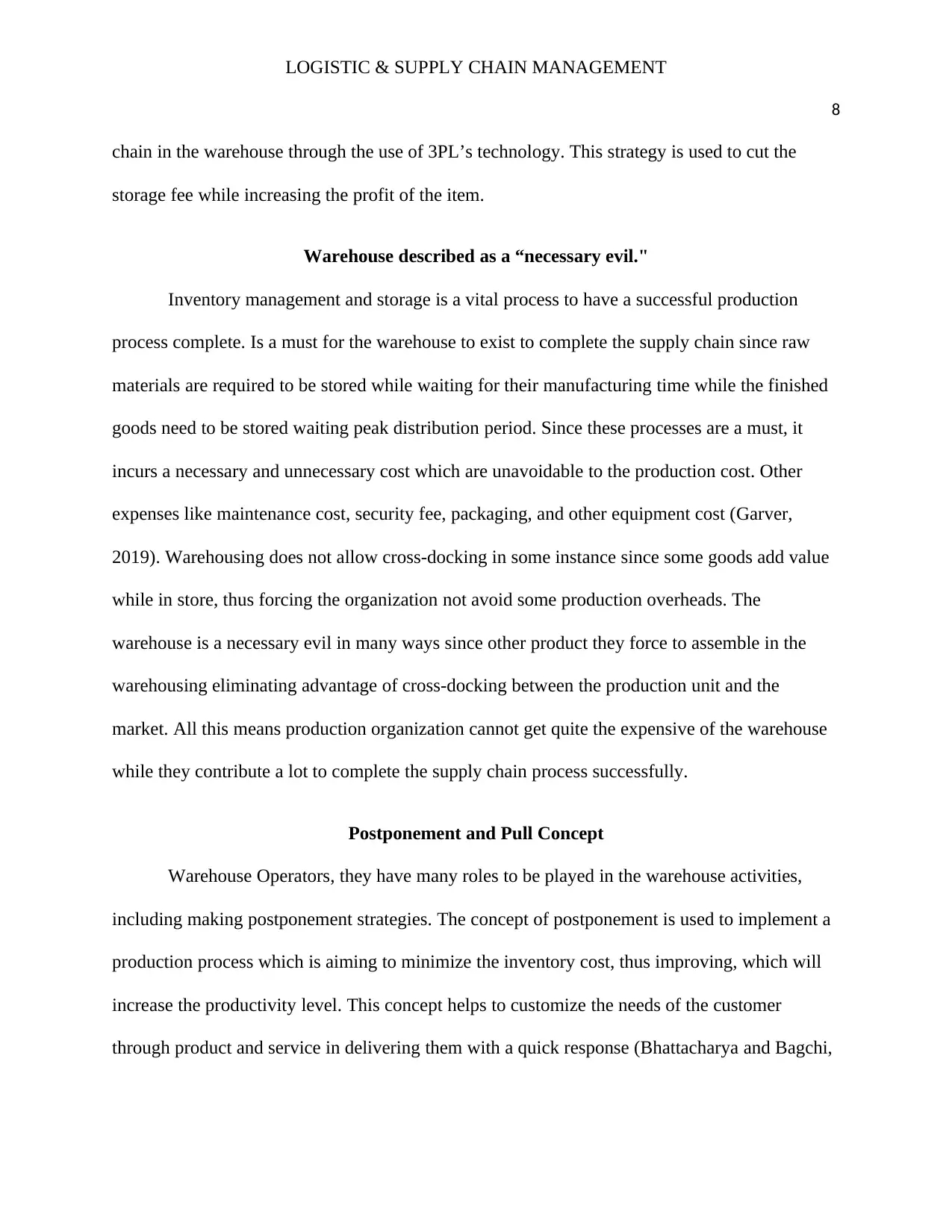
LOGISTIC & SUPPLY CHAIN MANAGEMENT
8
chain in the warehouse through the use of 3PL’s technology. This strategy is used to cut the
storage fee while increasing the profit of the item.
Warehouse described as a “necessary evil."
Inventory management and storage is a vital process to have a successful production
process complete. Is a must for the warehouse to exist to complete the supply chain since raw
materials are required to be stored while waiting for their manufacturing time while the finished
goods need to be stored waiting peak distribution period. Since these processes are a must, it
incurs a necessary and unnecessary cost which are unavoidable to the production cost. Other
expenses like maintenance cost, security fee, packaging, and other equipment cost (Garver,
2019). Warehousing does not allow cross-docking in some instance since some goods add value
while in store, thus forcing the organization not avoid some production overheads. The
warehouse is a necessary evil in many ways since other product they force to assemble in the
warehousing eliminating advantage of cross-docking between the production unit and the
market. All this means production organization cannot get quite the expensive of the warehouse
while they contribute a lot to complete the supply chain process successfully.
Postponement and Pull Concept
Warehouse Operators, they have many roles to be played in the warehouse activities,
including making postponement strategies. The concept of postponement is used to implement a
production process which is aiming to minimize the inventory cost, thus improving, which will
increase the productivity level. This concept helps to customize the needs of the customer
through product and service in delivering them with a quick response (Bhattacharya and Bagchi,
8
chain in the warehouse through the use of 3PL’s technology. This strategy is used to cut the
storage fee while increasing the profit of the item.
Warehouse described as a “necessary evil."
Inventory management and storage is a vital process to have a successful production
process complete. Is a must for the warehouse to exist to complete the supply chain since raw
materials are required to be stored while waiting for their manufacturing time while the finished
goods need to be stored waiting peak distribution period. Since these processes are a must, it
incurs a necessary and unnecessary cost which are unavoidable to the production cost. Other
expenses like maintenance cost, security fee, packaging, and other equipment cost (Garver,
2019). Warehousing does not allow cross-docking in some instance since some goods add value
while in store, thus forcing the organization not avoid some production overheads. The
warehouse is a necessary evil in many ways since other product they force to assemble in the
warehousing eliminating advantage of cross-docking between the production unit and the
market. All this means production organization cannot get quite the expensive of the warehouse
while they contribute a lot to complete the supply chain process successfully.
Postponement and Pull Concept
Warehouse Operators, they have many roles to be played in the warehouse activities,
including making postponement strategies. The concept of postponement is used to implement a
production process which is aiming to minimize the inventory cost, thus improving, which will
increase the productivity level. This concept helps to customize the needs of the customer
through product and service in delivering them with a quick response (Bhattacharya and Bagchi,
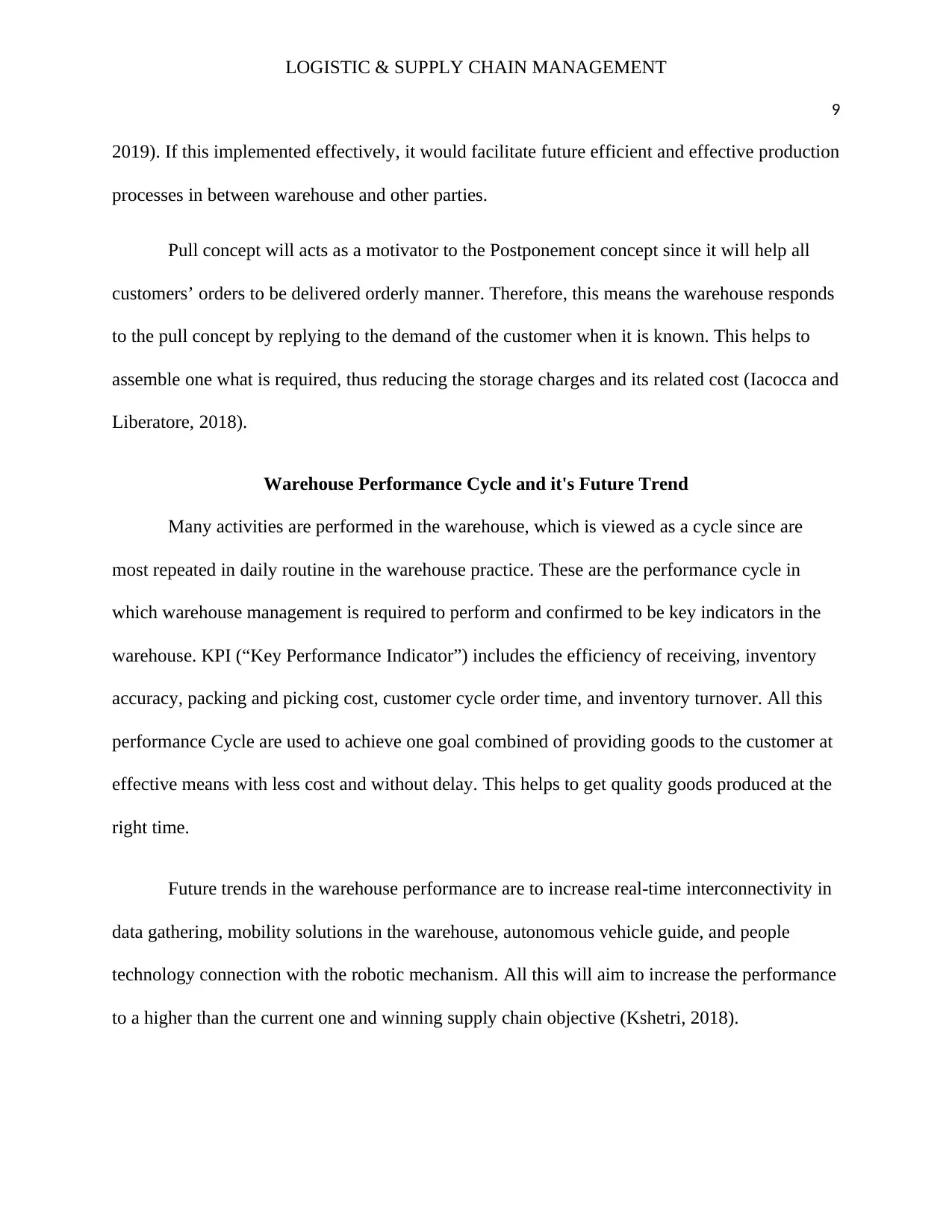
LOGISTIC & SUPPLY CHAIN MANAGEMENT
9
2019). If this implemented effectively, it would facilitate future efficient and effective production
processes in between warehouse and other parties.
Pull concept will acts as a motivator to the Postponement concept since it will help all
customers’ orders to be delivered orderly manner. Therefore, this means the warehouse responds
to the pull concept by replying to the demand of the customer when it is known. This helps to
assemble one what is required, thus reducing the storage charges and its related cost (Iacocca and
Liberatore, 2018).
Warehouse Performance Cycle and it's Future Trend
Many activities are performed in the warehouse, which is viewed as a cycle since are
most repeated in daily routine in the warehouse practice. These are the performance cycle in
which warehouse management is required to perform and confirmed to be key indicators in the
warehouse. KPI (“Key Performance Indicator”) includes the efficiency of receiving, inventory
accuracy, packing and picking cost, customer cycle order time, and inventory turnover. All this
performance Cycle are used to achieve one goal combined of providing goods to the customer at
effective means with less cost and without delay. This helps to get quality goods produced at the
right time.
Future trends in the warehouse performance are to increase real-time interconnectivity in
data gathering, mobility solutions in the warehouse, autonomous vehicle guide, and people
technology connection with the robotic mechanism. All this will aim to increase the performance
to a higher than the current one and winning supply chain objective (Kshetri, 2018).
9
2019). If this implemented effectively, it would facilitate future efficient and effective production
processes in between warehouse and other parties.
Pull concept will acts as a motivator to the Postponement concept since it will help all
customers’ orders to be delivered orderly manner. Therefore, this means the warehouse responds
to the pull concept by replying to the demand of the customer when it is known. This helps to
assemble one what is required, thus reducing the storage charges and its related cost (Iacocca and
Liberatore, 2018).
Warehouse Performance Cycle and it's Future Trend
Many activities are performed in the warehouse, which is viewed as a cycle since are
most repeated in daily routine in the warehouse practice. These are the performance cycle in
which warehouse management is required to perform and confirmed to be key indicators in the
warehouse. KPI (“Key Performance Indicator”) includes the efficiency of receiving, inventory
accuracy, packing and picking cost, customer cycle order time, and inventory turnover. All this
performance Cycle are used to achieve one goal combined of providing goods to the customer at
effective means with less cost and without delay. This helps to get quality goods produced at the
right time.
Future trends in the warehouse performance are to increase real-time interconnectivity in
data gathering, mobility solutions in the warehouse, autonomous vehicle guide, and people
technology connection with the robotic mechanism. All this will aim to increase the performance
to a higher than the current one and winning supply chain objective (Kshetri, 2018).
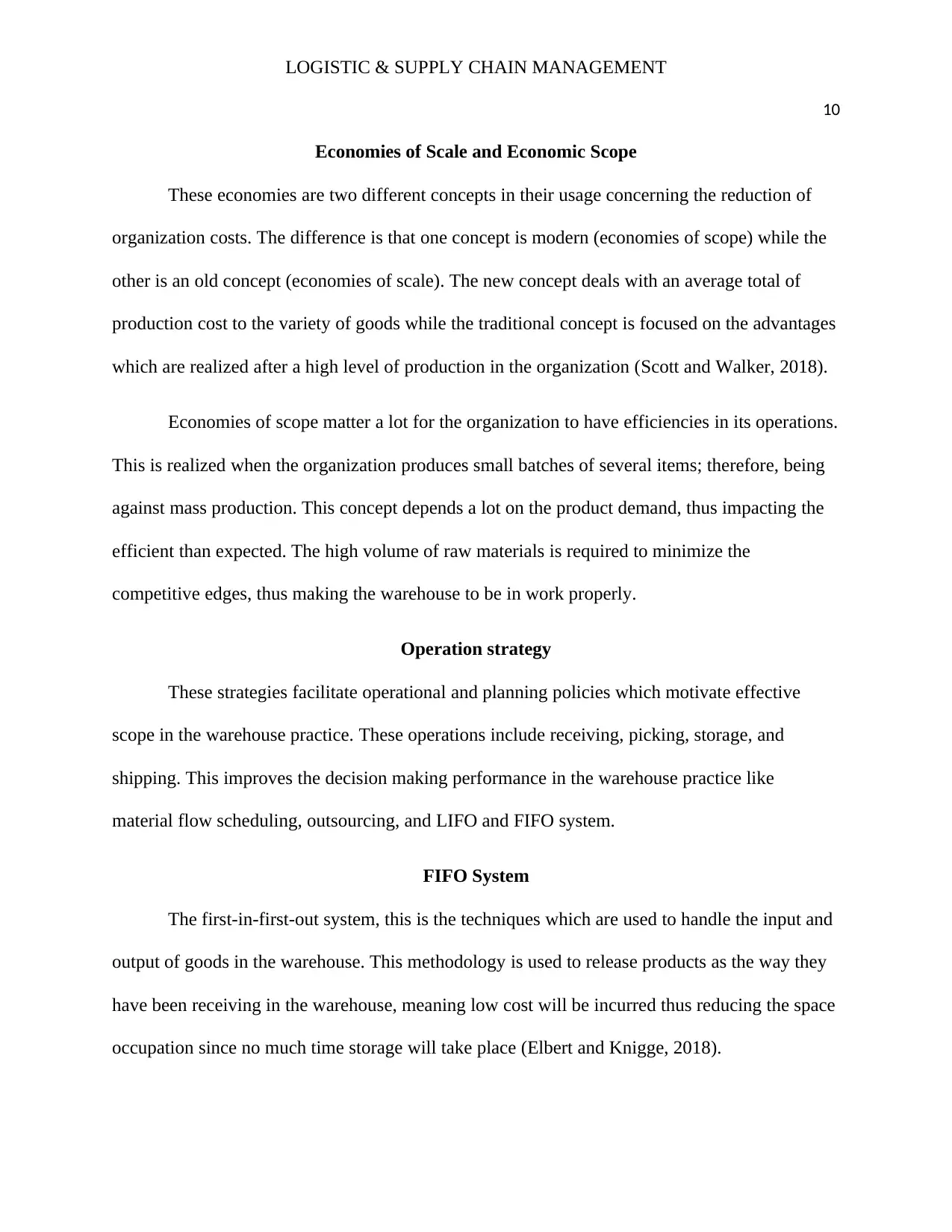
LOGISTIC & SUPPLY CHAIN MANAGEMENT
10
Economies of Scale and Economic Scope
These economies are two different concepts in their usage concerning the reduction of
organization costs. The difference is that one concept is modern (economies of scope) while the
other is an old concept (economies of scale). The new concept deals with an average total of
production cost to the variety of goods while the traditional concept is focused on the advantages
which are realized after a high level of production in the organization (Scott and Walker, 2018).
Economies of scope matter a lot for the organization to have efficiencies in its operations.
This is realized when the organization produces small batches of several items; therefore, being
against mass production. This concept depends a lot on the product demand, thus impacting the
efficient than expected. The high volume of raw materials is required to minimize the
competitive edges, thus making the warehouse to be in work properly.
Operation strategy
These strategies facilitate operational and planning policies which motivate effective
scope in the warehouse practice. These operations include receiving, picking, storage, and
shipping. This improves the decision making performance in the warehouse practice like
material flow scheduling, outsourcing, and LIFO and FIFO system.
FIFO System
The first-in-first-out system, this is the techniques which are used to handle the input and
output of goods in the warehouse. This methodology is used to release products as the way they
have been receiving in the warehouse, meaning low cost will be incurred thus reducing the space
occupation since no much time storage will take place (Elbert and Knigge, 2018).
10
Economies of Scale and Economic Scope
These economies are two different concepts in their usage concerning the reduction of
organization costs. The difference is that one concept is modern (economies of scope) while the
other is an old concept (economies of scale). The new concept deals with an average total of
production cost to the variety of goods while the traditional concept is focused on the advantages
which are realized after a high level of production in the organization (Scott and Walker, 2018).
Economies of scope matter a lot for the organization to have efficiencies in its operations.
This is realized when the organization produces small batches of several items; therefore, being
against mass production. This concept depends a lot on the product demand, thus impacting the
efficient than expected. The high volume of raw materials is required to minimize the
competitive edges, thus making the warehouse to be in work properly.
Operation strategy
These strategies facilitate operational and planning policies which motivate effective
scope in the warehouse practice. These operations include receiving, picking, storage, and
shipping. This improves the decision making performance in the warehouse practice like
material flow scheduling, outsourcing, and LIFO and FIFO system.
FIFO System
The first-in-first-out system, this is the techniques which are used to handle the input and
output of goods in the warehouse. This methodology is used to release products as the way they
have been receiving in the warehouse, meaning low cost will be incurred thus reducing the space
occupation since no much time storage will take place (Elbert and Knigge, 2018).
Secure Best Marks with AI Grader
Need help grading? Try our AI Grader for instant feedback on your assignments.
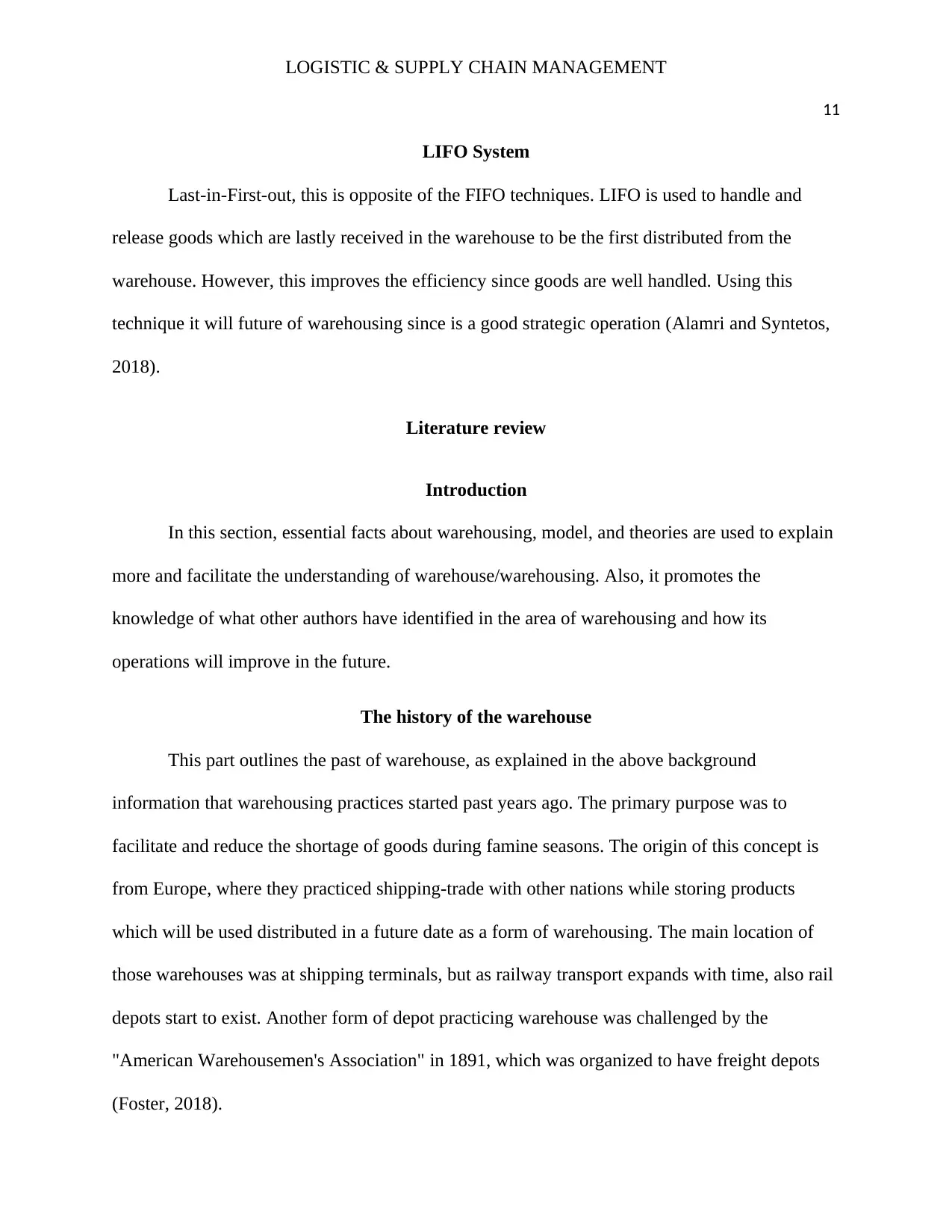
LOGISTIC & SUPPLY CHAIN MANAGEMENT
11
LIFO System
Last-in-First-out, this is opposite of the FIFO techniques. LIFO is used to handle and
release goods which are lastly received in the warehouse to be the first distributed from the
warehouse. However, this improves the efficiency since goods are well handled. Using this
technique it will future of warehousing since is a good strategic operation (Alamri and Syntetos,
2018).
Literature review
Introduction
In this section, essential facts about warehousing, model, and theories are used to explain
more and facilitate the understanding of warehouse/warehousing. Also, it promotes the
knowledge of what other authors have identified in the area of warehousing and how its
operations will improve in the future.
The history of the warehouse
This part outlines the past of warehouse, as explained in the above background
information that warehousing practices started past years ago. The primary purpose was to
facilitate and reduce the shortage of goods during famine seasons. The origin of this concept is
from Europe, where they practiced shipping-trade with other nations while storing products
which will be used distributed in a future date as a form of warehousing. The main location of
those warehouses was at shipping terminals, but as railway transport expands with time, also rail
depots start to exist. Another form of depot practicing warehouse was challenged by the
"American Warehousemen's Association" in 1891, which was organized to have freight depots
(Foster, 2018).
11
LIFO System
Last-in-First-out, this is opposite of the FIFO techniques. LIFO is used to handle and
release goods which are lastly received in the warehouse to be the first distributed from the
warehouse. However, this improves the efficiency since goods are well handled. Using this
technique it will future of warehousing since is a good strategic operation (Alamri and Syntetos,
2018).
Literature review
Introduction
In this section, essential facts about warehousing, model, and theories are used to explain
more and facilitate the understanding of warehouse/warehousing. Also, it promotes the
knowledge of what other authors have identified in the area of warehousing and how its
operations will improve in the future.
The history of the warehouse
This part outlines the past of warehouse, as explained in the above background
information that warehousing practices started past years ago. The primary purpose was to
facilitate and reduce the shortage of goods during famine seasons. The origin of this concept is
from Europe, where they practiced shipping-trade with other nations while storing products
which will be used distributed in a future date as a form of warehousing. The main location of
those warehouses was at shipping terminals, but as railway transport expands with time, also rail
depots start to exist. Another form of depot practicing warehouse was challenged by the
"American Warehousemen's Association" in 1891, which was organized to have freight depots
(Foster, 2018).
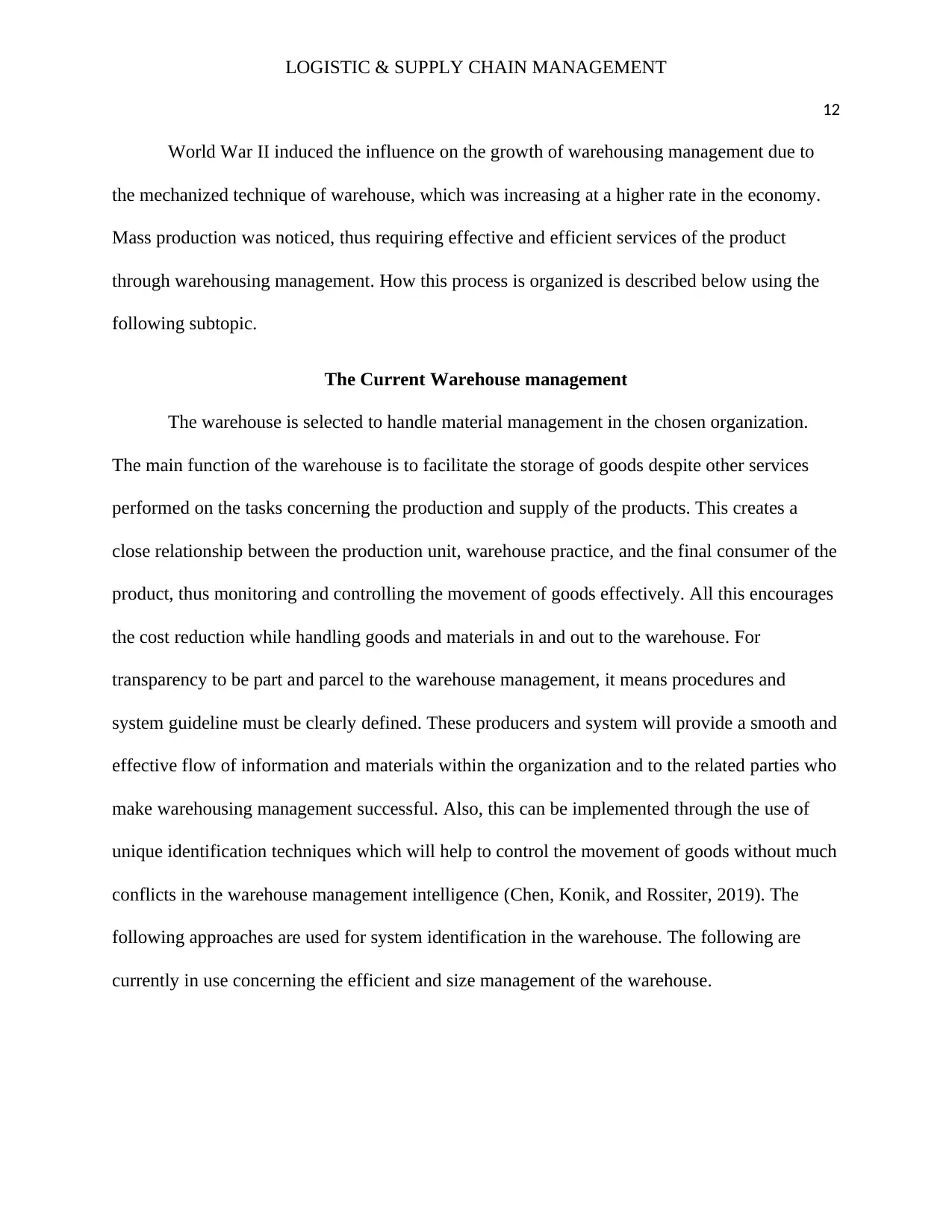
LOGISTIC & SUPPLY CHAIN MANAGEMENT
12
World War II induced the influence on the growth of warehousing management due to
the mechanized technique of warehouse, which was increasing at a higher rate in the economy.
Mass production was noticed, thus requiring effective and efficient services of the product
through warehousing management. How this process is organized is described below using the
following subtopic.
The Current Warehouse management
The warehouse is selected to handle material management in the chosen organization.
The main function of the warehouse is to facilitate the storage of goods despite other services
performed on the tasks concerning the production and supply of the products. This creates a
close relationship between the production unit, warehouse practice, and the final consumer of the
product, thus monitoring and controlling the movement of goods effectively. All this encourages
the cost reduction while handling goods and materials in and out to the warehouse. For
transparency to be part and parcel to the warehouse management, it means procedures and
system guideline must be clearly defined. These producers and system will provide a smooth and
effective flow of information and materials within the organization and to the related parties who
make warehousing management successful. Also, this can be implemented through the use of
unique identification techniques which will help to control the movement of goods without much
conflicts in the warehouse management intelligence (Chen, Konik, and Rossiter, 2019). The
following approaches are used for system identification in the warehouse. The following are
currently in use concerning the efficient and size management of the warehouse.
12
World War II induced the influence on the growth of warehousing management due to
the mechanized technique of warehouse, which was increasing at a higher rate in the economy.
Mass production was noticed, thus requiring effective and efficient services of the product
through warehousing management. How this process is organized is described below using the
following subtopic.
The Current Warehouse management
The warehouse is selected to handle material management in the chosen organization.
The main function of the warehouse is to facilitate the storage of goods despite other services
performed on the tasks concerning the production and supply of the products. This creates a
close relationship between the production unit, warehouse practice, and the final consumer of the
product, thus monitoring and controlling the movement of goods effectively. All this encourages
the cost reduction while handling goods and materials in and out to the warehouse. For
transparency to be part and parcel to the warehouse management, it means procedures and
system guideline must be clearly defined. These producers and system will provide a smooth and
effective flow of information and materials within the organization and to the related parties who
make warehousing management successful. Also, this can be implemented through the use of
unique identification techniques which will help to control the movement of goods without much
conflicts in the warehouse management intelligence (Chen, Konik, and Rossiter, 2019). The
following approaches are used for system identification in the warehouse. The following are
currently in use concerning the efficient and size management of the warehouse.
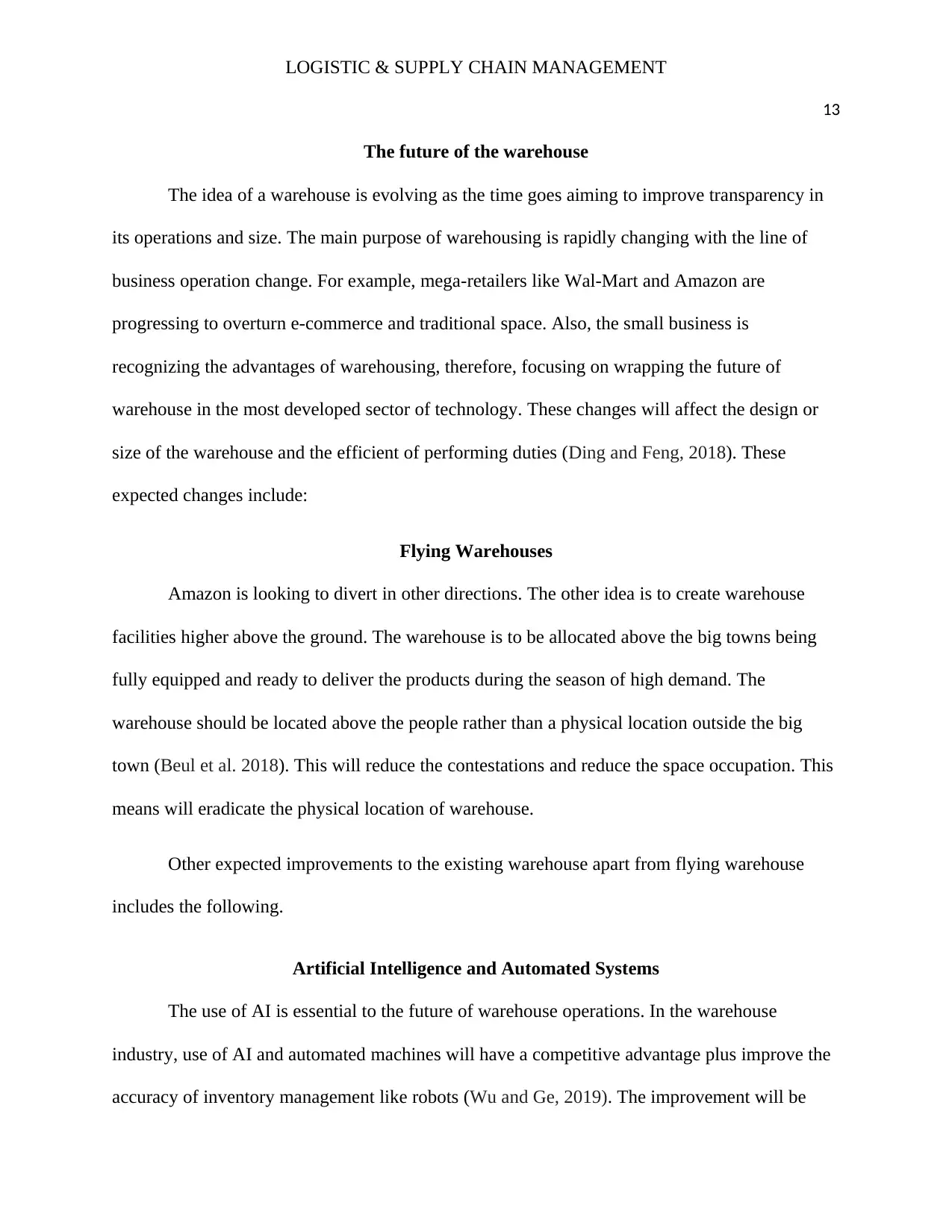
LOGISTIC & SUPPLY CHAIN MANAGEMENT
13
The future of the warehouse
The idea of a warehouse is evolving as the time goes aiming to improve transparency in
its operations and size. The main purpose of warehousing is rapidly changing with the line of
business operation change. For example, mega-retailers like Wal-Mart and Amazon are
progressing to overturn e-commerce and traditional space. Also, the small business is
recognizing the advantages of warehousing, therefore, focusing on wrapping the future of
warehouse in the most developed sector of technology. These changes will affect the design or
size of the warehouse and the efficient of performing duties (Ding and Feng, 2018). These
expected changes include:
Flying Warehouses
Amazon is looking to divert in other directions. The other idea is to create warehouse
facilities higher above the ground. The warehouse is to be allocated above the big towns being
fully equipped and ready to deliver the products during the season of high demand. The
warehouse should be located above the people rather than a physical location outside the big
town (Beul et al. 2018). This will reduce the contestations and reduce the space occupation. This
means will eradicate the physical location of warehouse.
Other expected improvements to the existing warehouse apart from flying warehouse
includes the following.
Artificial Intelligence and Automated Systems
The use of AI is essential to the future of warehouse operations. In the warehouse
industry, use of AI and automated machines will have a competitive advantage plus improve the
accuracy of inventory management like robots (Wu and Ge, 2019). The improvement will be
13
The future of the warehouse
The idea of a warehouse is evolving as the time goes aiming to improve transparency in
its operations and size. The main purpose of warehousing is rapidly changing with the line of
business operation change. For example, mega-retailers like Wal-Mart and Amazon are
progressing to overturn e-commerce and traditional space. Also, the small business is
recognizing the advantages of warehousing, therefore, focusing on wrapping the future of
warehouse in the most developed sector of technology. These changes will affect the design or
size of the warehouse and the efficient of performing duties (Ding and Feng, 2018). These
expected changes include:
Flying Warehouses
Amazon is looking to divert in other directions. The other idea is to create warehouse
facilities higher above the ground. The warehouse is to be allocated above the big towns being
fully equipped and ready to deliver the products during the season of high demand. The
warehouse should be located above the people rather than a physical location outside the big
town (Beul et al. 2018). This will reduce the contestations and reduce the space occupation. This
means will eradicate the physical location of warehouse.
Other expected improvements to the existing warehouse apart from flying warehouse
includes the following.
Artificial Intelligence and Automated Systems
The use of AI is essential to the future of warehouse operations. In the warehouse
industry, use of AI and automated machines will have a competitive advantage plus improve the
accuracy of inventory management like robots (Wu and Ge, 2019). The improvement will be
Paraphrase This Document
Need a fresh take? Get an instant paraphrase of this document with our AI Paraphraser

LOGISTIC & SUPPLY CHAIN MANAGEMENT
14
realized through the use of speech recognition machines and robots. For example, machine
learning used to improve decision making through performing huge data collection according to
the data of more ordered products, shipping, and inventory level. Use of robots can be used to
load and offload items, and performing other intensive labor tasks within the warehouse. Speech
recognition is achieved successfully through the use of software installed to the warehouse
machines, thus tracking customers' orders with minimal efforts. The performance of AI will
improve the productivity, efficiency, and inventory accuracy of the Key Performance Indicators
(KPIs) (Klumpp, 2018).
Robots will work more efficient with additional intelligence, which will facilitate
learning new abilities like video and image identification skills. For example, more tasks, like
order picking, will be performed automatically, thus reducing operational cost to 40%. Advanced
robots will perform superior package design, order picking, and other tasks, which is more
repetitive.
Gap Analysis
The main impact of new technology and the use of AI techniques in the warehouse is
aiming to reduce the space of operation and improve the productivity level. After analysis from
the current activities of the warehouse is that are more effort use and time-consuming. Large area
and more personnel are required, which makes the operation more expensive compared to
service offered. However, the use of new technology in the warehouse activities, it will improve
the efficiency and effectiveness at a more significant level. Much of the events will be
automated, and less time will be used to process an order with little effort, a quality product will
be released due to standardized, among others. The most recent challenge and the gap in the
14
realized through the use of speech recognition machines and robots. For example, machine
learning used to improve decision making through performing huge data collection according to
the data of more ordered products, shipping, and inventory level. Use of robots can be used to
load and offload items, and performing other intensive labor tasks within the warehouse. Speech
recognition is achieved successfully through the use of software installed to the warehouse
machines, thus tracking customers' orders with minimal efforts. The performance of AI will
improve the productivity, efficiency, and inventory accuracy of the Key Performance Indicators
(KPIs) (Klumpp, 2018).
Robots will work more efficient with additional intelligence, which will facilitate
learning new abilities like video and image identification skills. For example, more tasks, like
order picking, will be performed automatically, thus reducing operational cost to 40%. Advanced
robots will perform superior package design, order picking, and other tasks, which is more
repetitive.
Gap Analysis
The main impact of new technology and the use of AI techniques in the warehouse is
aiming to reduce the space of operation and improve the productivity level. After analysis from
the current activities of the warehouse is that are more effort use and time-consuming. Large area
and more personnel are required, which makes the operation more expensive compared to
service offered. However, the use of new technology in the warehouse activities, it will improve
the efficiency and effectiveness at a more significant level. Much of the events will be
automated, and less time will be used to process an order with little effort, a quality product will
be released due to standardized, among others. The most recent challenge and the gap in the

LOGISTIC & SUPPLY CHAIN MANAGEMENT
15
warehouse industry is going to handles in a better way in coming years through the use advanced
technology techniques as discussed above, in what is expected in the future (Seelen, Daily and
Dunn, 2018). This will help to achieve the goal of space utilization compared to the current
warehouse techniques.
Innovative Idea
An innovative idea is essential to achieve the future of warehousing concept. An
innovative approach will help to have a more productive warehouse with minimal cost and space
in the future. These ideas which warehousing concept is aiming to apply includes; having fully
equipped programmed machine warehouse without no existence of human kind in any way, only
the command and the will be done. Another innovation is where the full of warehouse activities
will be performed virtually through cloud storage. The AI technique will be fully utilized and not
partially like currently.
Summary and Recommendation
In Summary, warehousing is a very critical pillar to the success of all business activities.
Therefore, it is recommended to design and implement effective warehousing techniques which
will facilitate efficiency and effectiveness of the performance. Different techniques and
terminology have been discussed in the above report as a requirement to understand more of the
warehousing methodology. The integration and warehousing management have been improved
very much using modern technology in the sector of supply chain and logistics management. Is
recommended that the current information technology techniques are required as like other
factors to have adequate time management, accurate measurement of the warehouse
performance, improve quality of the product, therefore, all this aiming to increase warehouse
15
warehouse industry is going to handles in a better way in coming years through the use advanced
technology techniques as discussed above, in what is expected in the future (Seelen, Daily and
Dunn, 2018). This will help to achieve the goal of space utilization compared to the current
warehouse techniques.
Innovative Idea
An innovative idea is essential to achieve the future of warehousing concept. An
innovative approach will help to have a more productive warehouse with minimal cost and space
in the future. These ideas which warehousing concept is aiming to apply includes; having fully
equipped programmed machine warehouse without no existence of human kind in any way, only
the command and the will be done. Another innovation is where the full of warehouse activities
will be performed virtually through cloud storage. The AI technique will be fully utilized and not
partially like currently.
Summary and Recommendation
In Summary, warehousing is a very critical pillar to the success of all business activities.
Therefore, it is recommended to design and implement effective warehousing techniques which
will facilitate efficiency and effectiveness of the performance. Different techniques and
terminology have been discussed in the above report as a requirement to understand more of the
warehousing methodology. The integration and warehousing management have been improved
very much using modern technology in the sector of supply chain and logistics management. Is
recommended that the current information technology techniques are required as like other
factors to have adequate time management, accurate measurement of the warehouse
performance, improve quality of the product, therefore, all this aiming to increase warehouse
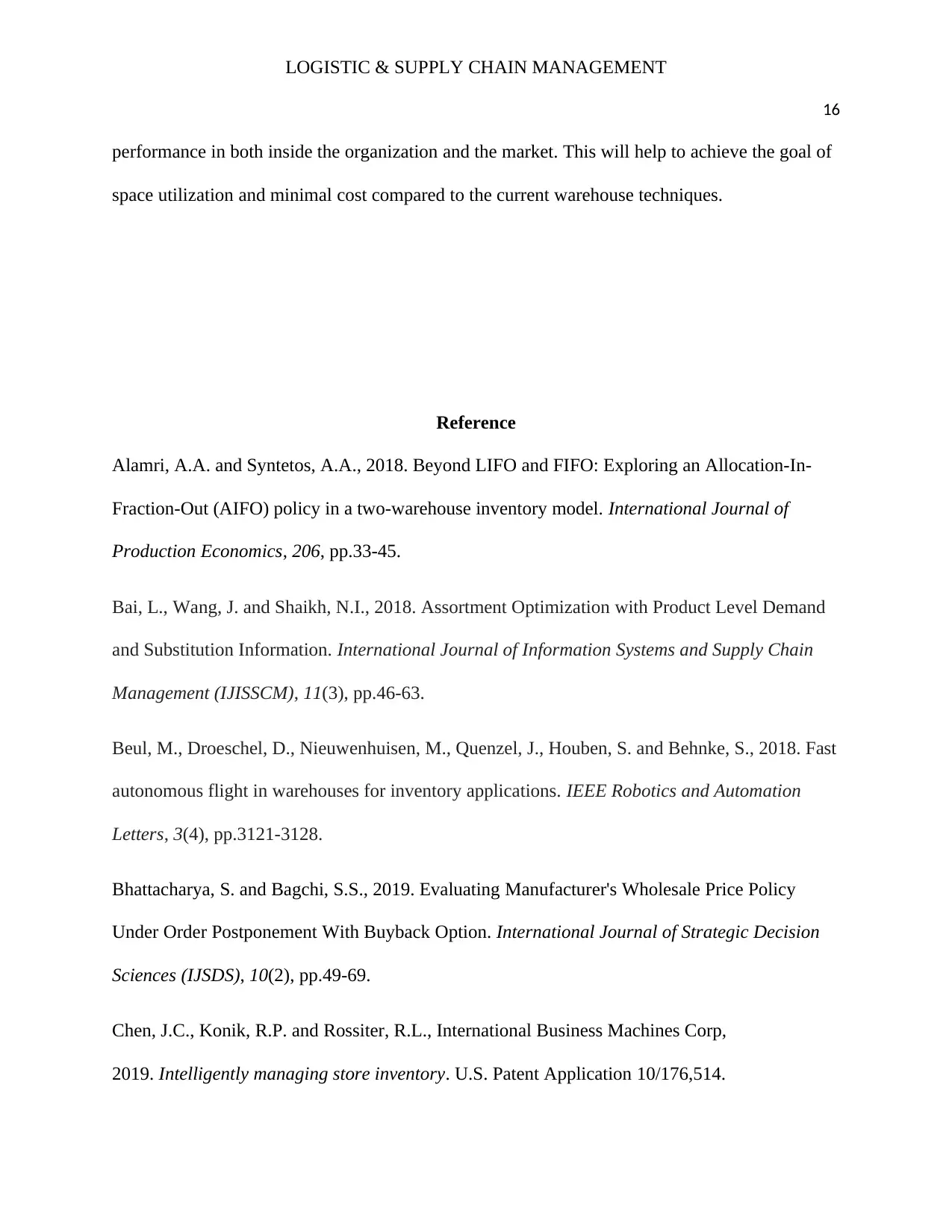
LOGISTIC & SUPPLY CHAIN MANAGEMENT
16
performance in both inside the organization and the market. This will help to achieve the goal of
space utilization and minimal cost compared to the current warehouse techniques.
Reference
Alamri, A.A. and Syntetos, A.A., 2018. Beyond LIFO and FIFO: Exploring an Allocation-In-
Fraction-Out (AIFO) policy in a two-warehouse inventory model. International Journal of
Production Economics, 206, pp.33-45.
Bai, L., Wang, J. and Shaikh, N.I., 2018. Assortment Optimization with Product Level Demand
and Substitution Information. International Journal of Information Systems and Supply Chain
Management (IJISSCM), 11(3), pp.46-63.
Beul, M., Droeschel, D., Nieuwenhuisen, M., Quenzel, J., Houben, S. and Behnke, S., 2018. Fast
autonomous flight in warehouses for inventory applications. IEEE Robotics and Automation
Letters, 3(4), pp.3121-3128.
Bhattacharya, S. and Bagchi, S.S., 2019. Evaluating Manufacturer's Wholesale Price Policy
Under Order Postponement With Buyback Option. International Journal of Strategic Decision
Sciences (IJSDS), 10(2), pp.49-69.
Chen, J.C., Konik, R.P. and Rossiter, R.L., International Business Machines Corp,
2019. Intelligently managing store inventory. U.S. Patent Application 10/176,514.
16
performance in both inside the organization and the market. This will help to achieve the goal of
space utilization and minimal cost compared to the current warehouse techniques.
Reference
Alamri, A.A. and Syntetos, A.A., 2018. Beyond LIFO and FIFO: Exploring an Allocation-In-
Fraction-Out (AIFO) policy in a two-warehouse inventory model. International Journal of
Production Economics, 206, pp.33-45.
Bai, L., Wang, J. and Shaikh, N.I., 2018. Assortment Optimization with Product Level Demand
and Substitution Information. International Journal of Information Systems and Supply Chain
Management (IJISSCM), 11(3), pp.46-63.
Beul, M., Droeschel, D., Nieuwenhuisen, M., Quenzel, J., Houben, S. and Behnke, S., 2018. Fast
autonomous flight in warehouses for inventory applications. IEEE Robotics and Automation
Letters, 3(4), pp.3121-3128.
Bhattacharya, S. and Bagchi, S.S., 2019. Evaluating Manufacturer's Wholesale Price Policy
Under Order Postponement With Buyback Option. International Journal of Strategic Decision
Sciences (IJSDS), 10(2), pp.49-69.
Chen, J.C., Konik, R.P. and Rossiter, R.L., International Business Machines Corp,
2019. Intelligently managing store inventory. U.S. Patent Application 10/176,514.
Secure Best Marks with AI Grader
Need help grading? Try our AI Grader for instant feedback on your assignments.
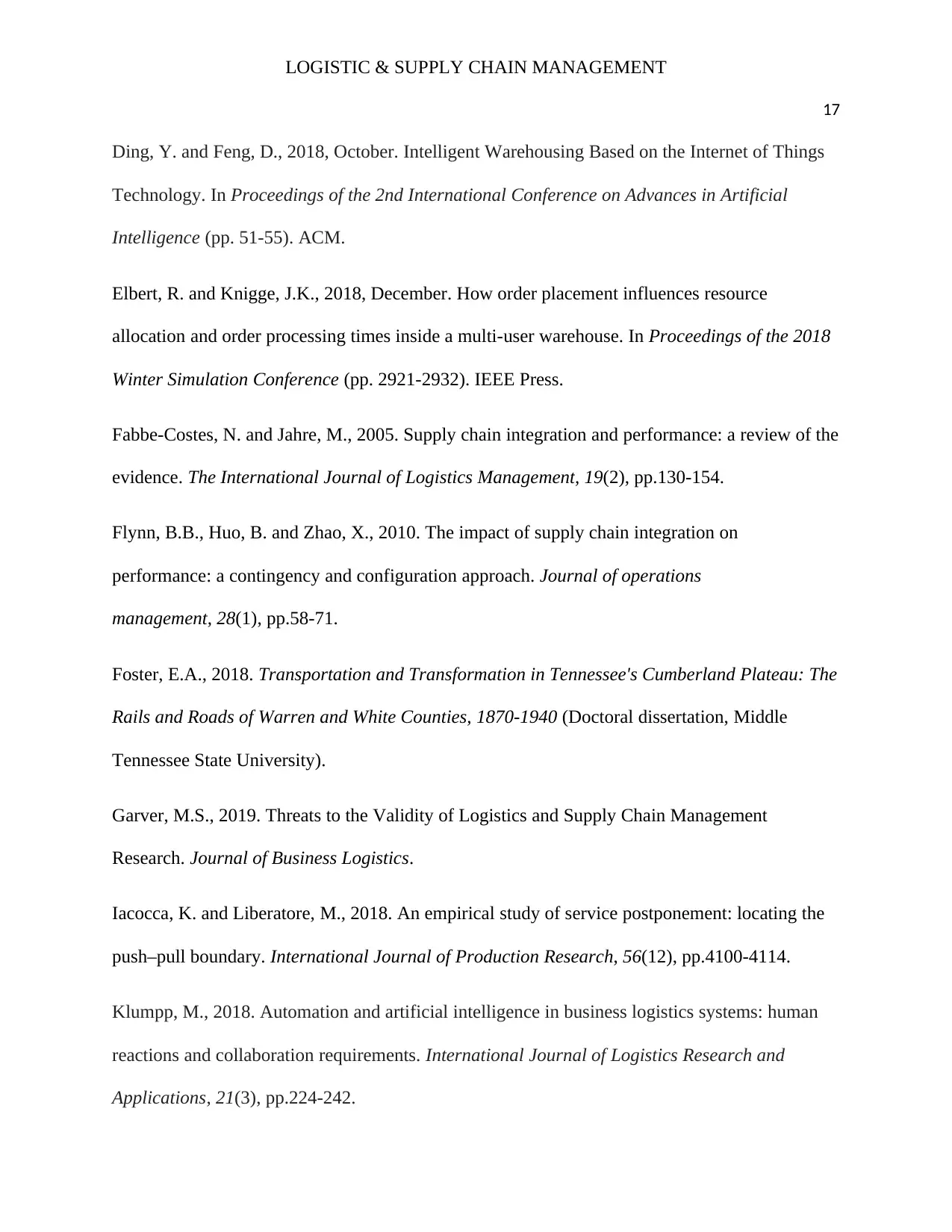
LOGISTIC & SUPPLY CHAIN MANAGEMENT
17
Ding, Y. and Feng, D., 2018, October. Intelligent Warehousing Based on the Internet of Things
Technology. In Proceedings of the 2nd International Conference on Advances in Artificial
Intelligence (pp. 51-55). ACM.
Elbert, R. and Knigge, J.K., 2018, December. How order placement influences resource
allocation and order processing times inside a multi-user warehouse. In Proceedings of the 2018
Winter Simulation Conference (pp. 2921-2932). IEEE Press.
Fabbe-Costes, N. and Jahre, M., 2005. Supply chain integration and performance: a review of the
evidence. The International Journal of Logistics Management, 19(2), pp.130-154.
Flynn, B.B., Huo, B. and Zhao, X., 2010. The impact of supply chain integration on
performance: a contingency and configuration approach. Journal of operations
management, 28(1), pp.58-71.
Foster, E.A., 2018. Transportation and Transformation in Tennessee's Cumberland Plateau: The
Rails and Roads of Warren and White Counties, 1870-1940 (Doctoral dissertation, Middle
Tennessee State University).
Garver, M.S., 2019. Threats to the Validity of Logistics and Supply Chain Management
Research. Journal of Business Logistics.
Iacocca, K. and Liberatore, M., 2018. An empirical study of service postponement: locating the
push–pull boundary. International Journal of Production Research, 56(12), pp.4100-4114.
Klumpp, M., 2018. Automation and artificial intelligence in business logistics systems: human
reactions and collaboration requirements. International Journal of Logistics Research and
Applications, 21(3), pp.224-242.
17
Ding, Y. and Feng, D., 2018, October. Intelligent Warehousing Based on the Internet of Things
Technology. In Proceedings of the 2nd International Conference on Advances in Artificial
Intelligence (pp. 51-55). ACM.
Elbert, R. and Knigge, J.K., 2018, December. How order placement influences resource
allocation and order processing times inside a multi-user warehouse. In Proceedings of the 2018
Winter Simulation Conference (pp. 2921-2932). IEEE Press.
Fabbe-Costes, N. and Jahre, M., 2005. Supply chain integration and performance: a review of the
evidence. The International Journal of Logistics Management, 19(2), pp.130-154.
Flynn, B.B., Huo, B. and Zhao, X., 2010. The impact of supply chain integration on
performance: a contingency and configuration approach. Journal of operations
management, 28(1), pp.58-71.
Foster, E.A., 2018. Transportation and Transformation in Tennessee's Cumberland Plateau: The
Rails and Roads of Warren and White Counties, 1870-1940 (Doctoral dissertation, Middle
Tennessee State University).
Garver, M.S., 2019. Threats to the Validity of Logistics and Supply Chain Management
Research. Journal of Business Logistics.
Iacocca, K. and Liberatore, M., 2018. An empirical study of service postponement: locating the
push–pull boundary. International Journal of Production Research, 56(12), pp.4100-4114.
Klumpp, M., 2018. Automation and artificial intelligence in business logistics systems: human
reactions and collaboration requirements. International Journal of Logistics Research and
Applications, 21(3), pp.224-242.
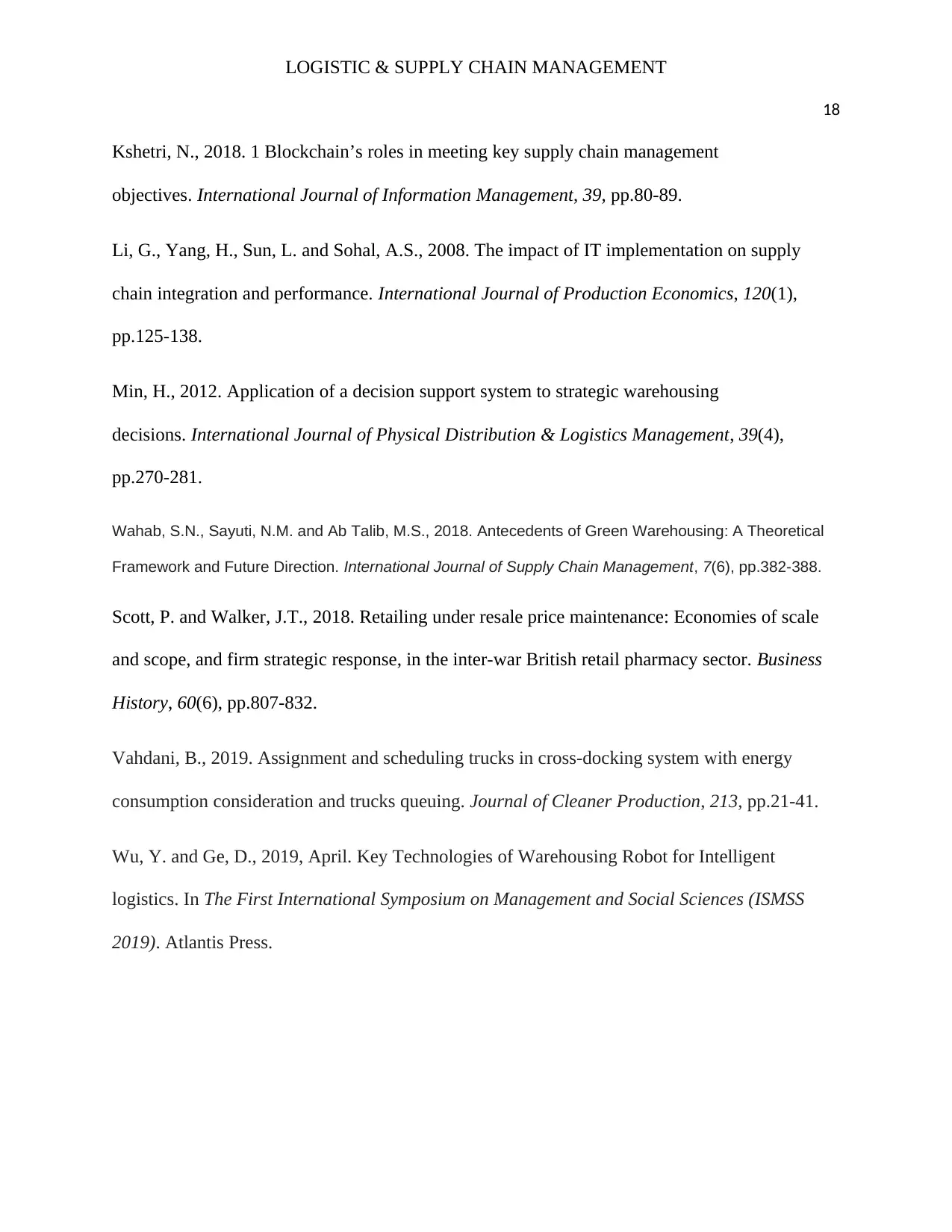
LOGISTIC & SUPPLY CHAIN MANAGEMENT
18
Kshetri, N., 2018. 1 Blockchain’s roles in meeting key supply chain management
objectives. International Journal of Information Management, 39, pp.80-89.
Li, G., Yang, H., Sun, L. and Sohal, A.S., 2008. The impact of IT implementation on supply
chain integration and performance. International Journal of Production Economics, 120(1),
pp.125-138.
Min, H., 2012. Application of a decision support system to strategic warehousing
decisions. International Journal of Physical Distribution & Logistics Management, 39(4),
pp.270-281.
Wahab, S.N., Sayuti, N.M. and Ab Talib, M.S., 2018. Antecedents of Green Warehousing: A Theoretical
Framework and Future Direction. International Journal of Supply Chain Management, 7(6), pp.382-388.
Scott, P. and Walker, J.T., 2018. Retailing under resale price maintenance: Economies of scale
and scope, and firm strategic response, in the inter-war British retail pharmacy sector. Business
History, 60(6), pp.807-832.
Vahdani, B., 2019. Assignment and scheduling trucks in cross-docking system with energy
consumption consideration and trucks queuing. Journal of Cleaner Production, 213, pp.21-41.
Wu, Y. and Ge, D., 2019, April. Key Technologies of Warehousing Robot for Intelligent
logistics. In The First International Symposium on Management and Social Sciences (ISMSS
2019). Atlantis Press.
18
Kshetri, N., 2018. 1 Blockchain’s roles in meeting key supply chain management
objectives. International Journal of Information Management, 39, pp.80-89.
Li, G., Yang, H., Sun, L. and Sohal, A.S., 2008. The impact of IT implementation on supply
chain integration and performance. International Journal of Production Economics, 120(1),
pp.125-138.
Min, H., 2012. Application of a decision support system to strategic warehousing
decisions. International Journal of Physical Distribution & Logistics Management, 39(4),
pp.270-281.
Wahab, S.N., Sayuti, N.M. and Ab Talib, M.S., 2018. Antecedents of Green Warehousing: A Theoretical
Framework and Future Direction. International Journal of Supply Chain Management, 7(6), pp.382-388.
Scott, P. and Walker, J.T., 2018. Retailing under resale price maintenance: Economies of scale
and scope, and firm strategic response, in the inter-war British retail pharmacy sector. Business
History, 60(6), pp.807-832.
Vahdani, B., 2019. Assignment and scheduling trucks in cross-docking system with energy
consumption consideration and trucks queuing. Journal of Cleaner Production, 213, pp.21-41.
Wu, Y. and Ge, D., 2019, April. Key Technologies of Warehousing Robot for Intelligent
logistics. In The First International Symposium on Management and Social Sciences (ISMSS
2019). Atlantis Press.

LOGISTIC & SUPPLY CHAIN MANAGEMENT
19
19
1 out of 19
Related Documents
Your All-in-One AI-Powered Toolkit for Academic Success.
+13062052269
info@desklib.com
Available 24*7 on WhatsApp / Email
![[object Object]](/_next/static/media/star-bottom.7253800d.svg)
Unlock your academic potential
© 2024 | Zucol Services PVT LTD | All rights reserved.





